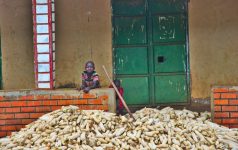Dalberg uses cookies and related technologies to improve the way the site functions. A cookie is a text file that is stored on your device. We use these text files for functionality such as to analyze our traffic or to personalize content. You can easily control how we use cookies on your device by adjusting the settings below, and you may also change those settings at any time by visiting our privacy policy page.
Widespread poverty in Uganda is closely related to food insecurity and malnutrition, with 36% of children in the country chronically undernourished or stunted. For development actors to effectively respond to crisis, they must be able to understand which communities are most vulnerable in real-time and at high geographic granularity. Food security intervention planning however often relies on outdated survey data, which harms the efficacy of these interventions.
Recent research indicates that mobile phone data can be linked to food insecurity because mobile phone usage patterns reveal shocks to household expenditure in real-time. Considering this research, Dalberg Data Insights has built a Food Security Manager that displays changes in mobile phone top-up patterns, where certain changes in spending serve as further indicators for changes in food spending. The Food Security Manager allows development actors to pinpoint where food shortages and malnutrition may occur so that food security actors can better distribute resources to the most vulnerable communities.
The development of the Food Security Manager was supported by the United Nations Capital Development Fund and the Belgian Development Cooperation in an effort to deliver better development outcomes using mobile phone data.
Dalberg Data Insights co-developed the tool with Hunger Fighters, a Uganda-based NGO with a vision of a hunger and malnutrition free Uganda that aims to create empowered, food secure communities. Their key programme areas include food and nutrition security, humanitarian support, agriculture and sustainable livelihoods and research and advocacy work. Hunger Fighters also works in partnership with the World Food Programme on a Food Basket Monitoring project with refugees.
Prior to our collaboration, Hunger Fighters’ strategy faced several data challenges:
- Needed access to real time data for decision-making
- Relied on surveys for data, with small sample sizes and geographic homogeneity
- Needed oversight on wider geographic trends, to aid with resource allocation of a small team
- Needed a central platform with a way to clearly visualise and analyse data
What We Built: Food Security Manager
We built an interactive tool that tracks mobile phone top-up spending as a non-food household expenditure, and market prices of crop staples across the Greater Kampala Metropolitan Area.
The methodology of the app is based on a research paper by Decupyer et al (2014) which compared several telecom variables to different food security and poverty linked indicators. High correlations (0.6 – 0.8) were found between top-up related indicators and expenditure on food or consumption of certain vegetable types.
Such results suggest that telecom data can be used as a real-time proxy for certain food security indicators, thus anticipating and identifying at-risk food insecure communities.
The Results:
Hunger Fighters Uganda are using the tool as part of their Edible Cities project, which is aimed at enhancing resilience, urban food security and livelihoods in urban areas, to:
• Provide information for better decision-making on resource allocation and intervention programmes
• Monitor long-term trends in key indicators and anticipate shocks in household spending patterns
• Increase engagement in evidence-based advocacy programme
What’s Next?
While analyzing mobile phone data is a first step in understanding food shortages, the integration of data sources will allow the development community to more effectively identify the early warning signs of food insecurity. Satellite imagery, for example, can help map the location of crops and estimate crop yield.
This data source integration will be supported by AIDA, a newly launched data platform built by Dalberg Data Insights in partnership with UNCDF. AIDA allows development partners and governments to access valuable data and provides them with the necessary support to transform this data into crucial insights to reach their development goals.
It is essential to build trust among the development community and work in partnership to close data gaps. Together, we can unlock data’s true potential by using intelligent insights to monitor and predict food shortages in the fight towards zero hunger.






